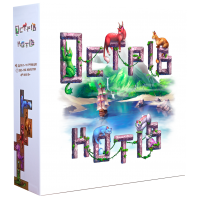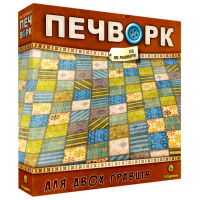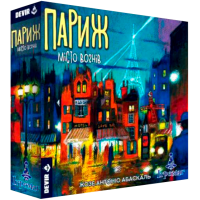Best Polymino Games
Related Products
One of the most popular game mechanics of board games is the polymino (Tetris, Mosaic) mechanic. It consists in laying out figures of various shapes on the field. Most often, the goal is to place the tiles in such a way that they completely cover the entire field. Games with these game mechanics are usually well-suited for family gatherings and novice players. Girls often like this kind of mechanics, so these games are well suited for putting their significant other on the table. However, let's do without gender stereotypes, I'd rather talk about the best games with this mechanic.
I will start, of course, with the most famous game of the genre - "Patchwork". The rules are simple: we take one of the three scrap tiles from the market and place it on the field. For large tiles, it is necessary to pay with buttons and loss of time, thanks to which the opponent can make several moves in a row. The goal is to fill most of the field, and ideally the entire field. The game is fast and simple, and it can be played in 15 minutes. Unfortunately, Patchwork can only be played by two people.
"Patchwork" was released in 2014, the author of the game was Uwe Rosenberg, famous for his large-scale Eurogames. Interestingly, Uwe originally came up with the "Patchwork" mechanic as an element for his next game, but he liked it so much that he decided to create a separate game. As a result, "Patchwork" became one of the most famous and popular board games. However, the low cost of the game contributed a lot to this.

"Bear Park" is another simple family game consisting entirely of "Tetris" mechanics. Up to 4 players can play it. During his turn, the player places a tile on the field, receiving other tiles in reserve based on which cells he closed. The player's field consists of sheets, and the earlier he fills the sheet, the more victory points he will receive. Victory points are also awarded for placing expensive tiles and completing objectives. The goals for each game are chosen differently, which ensures the variety of the game. The game is simple, played without tension, and a game for two lasts about 20 minutes.

Another short polymino relaxation game is the abstract "Project L" . However, it is very easy to fill out the field in it. The fact is that there are no complex-shaped "crakozabr" in this game, the figurines consist of a maximum of 4 cells. But the player can simultaneously fill up to 4 different fields. After filling the field, the player gets all the figures back - and one more that the field brings. In addition to the action of filling the figure, the player can improve the figure, get a new one, take another square from the market. It is worth noting the pleasant tactile sensations from the colorful glossy figures in the game, which fill the two-layer tablets. The game itself is simple, played quickly, the number of players is from 2 to 4.

I recommend Paris. City of Lights" . The uniqueness of the game is that the field where the players will place the figures is shared. And it is formed by the players themselves at the beginning of the game. However, there is no need to strive to fill it. Instead, players get points for placing figures next to lanterns. The points for a figure are equal to the figure's size multiplied by the number of adjacent lanterns - so one well-placed figure can yield most of the victory points. You should make your moves here, as in chess, based on how you would harm your opponent. This is achieved by placing your figure on common cells or drawing cards that give unique opportunities. The minus of the game is that it is only for two, and someone may not like the bland design of the game and large, but uninformative leaflets.

The novelty of polymino games is "Unknown Planet" . Here you need to place figurines in order to fill the field of the planet. In addition, each figure pumps two tracks. A total of 5 tracks: one works for victory points, another gives certain properties to the player, the third brings single-cell tokens to close holes. The most interesting red track, which allows you to move on the surface of the planet by an all-terrain vehicle that collects meteorites and rescue capsules.
The gameplay becomes noticeably more complicated if you choose advanced planets and corporations instead of standard ones. For example, one planet prohibits placing tiles of certain types in each sector of the planet, and another requires throwing all tiles down, as in "Tetris" (the planet, by the way, is named after the creator of "Tetris" Oleksiy Pazhitnov). You can add to the game a module of random events that trigger every round.
A plus is the possibility of playing with up to 6 people, while the time of playing with a large team does not increase much, since the progress of all players takes place simultaneously. The disadvantages are the weak interaction between players and the high price of the game.

My favorite polymino game is Cat Island. Added to the mechanics of placing cat pieces in this game are cards that players collect through the draft method. Some cards allow you to place cat tiles, others bring treasure, and still others are actually objective cards. The selected cards must be paid for in game currency - fish, which slightly compensates the players for success in the arrival of cards. Filling ship cabins with cat tiles is just one way to get points. Collecting cats of the same color touching each other brings much more victory points.
"Cat Island" is a beautiful, simple family game. The disadvantage of the game is the high dependence on success: whether the desired color of cats will come to the market, or whether profitable cards of goals (lessons) will come into the hand. But this has its own plus, because anyone can win the game!
There are also several additions to the game, but in my opinion, they are not mandatory.

In addition to the actual polymino games, there are many games that partially use this mechanic. For example, in the hardcore Euro zoo game Ark Nova , filling the zoo field with animal enclosures is an important element. In The Grand Show, a medium-difficulty Euro game with cards and dice, building a tent out of tiles is one of the three main actions. The player loses points for each unfilled section of the field at the end of the game. In the combined European game "Santa Maria", competent placement of tiles on the field is the key to victory. However, the field here is only 6 by 6 cells, so it is not the shape of the tiles that is more important, but what is drawn on them. Having mentioned "Santa Maria", I cannot but note that, despite the interesting gameplay, the game has ugly graphics.







